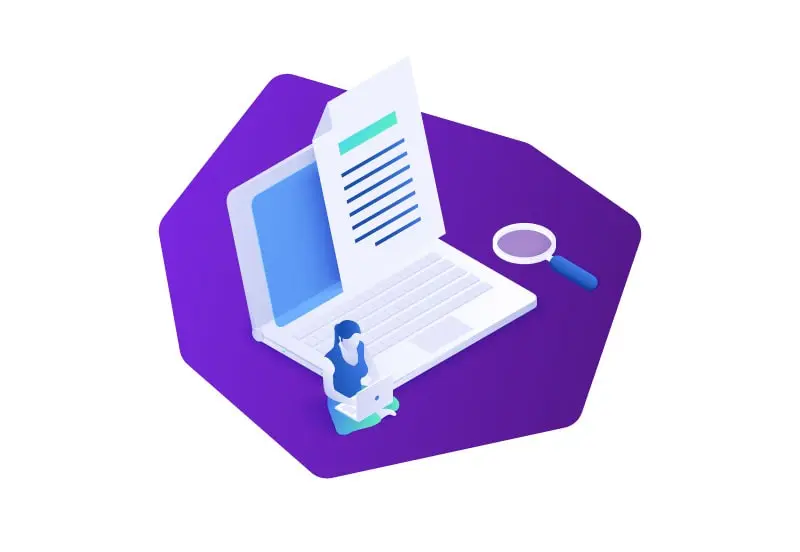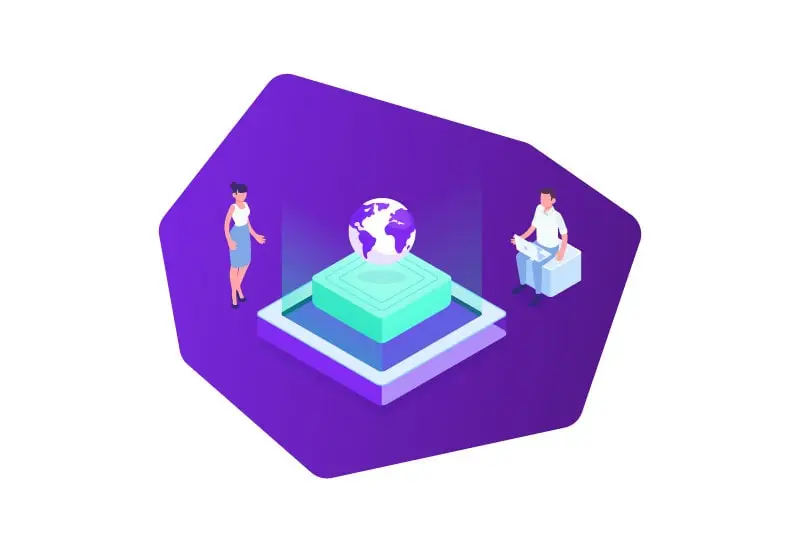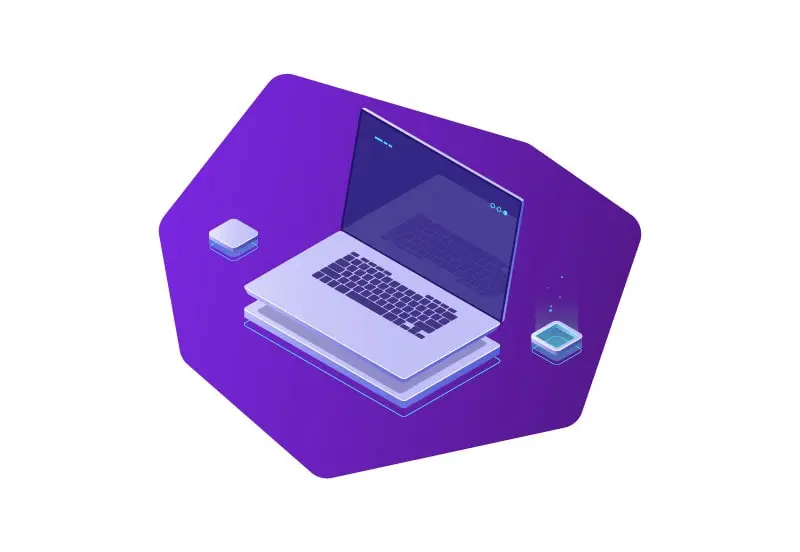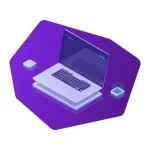In today’s digital landscape, web scraping has become a vital technique for extracting valuable data from websites. However, as websites become more complex with dynamic content and JavaScript-driven interactions, traditional scraping methods may fall short. This is where headless browsers come into play. Headless browsers allow us to interact with websites like a regular browser but without a visible user interface.
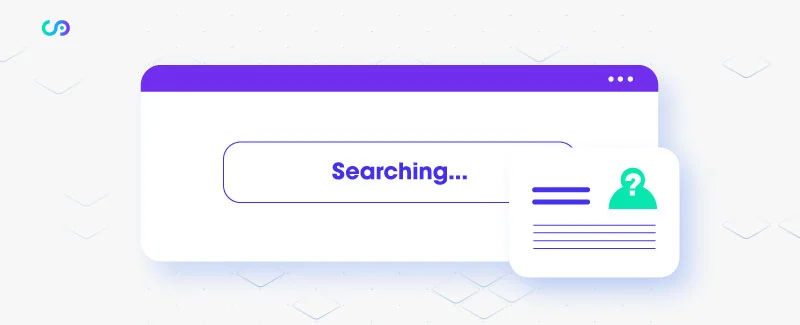
In this introduction to headless browser scraping, we will explore the fundamentals of web scraping and delve into the role of headless browsers in overcoming the challenges posed by modern websites. By leveraging headless browsers, web scrapers can enjoy benefits such as improved compatibility, enhanced speed, and the ability to handle dynamic content effectively. Join us as we uncover the power of headless browser web scraping and its significance in the world of web data extraction.
What is Headless Browser Web Scraping?
In the world of web scraping, headless browsers have emerged as powerful tools that revolutionize the data extraction process. Unlike traditional browsers, headless browsers operate without a graphical user interface (GUI), allowing them to run in the background and perform automated tasks. Headless browsers interact with websites just like regular browsers, but without the visual rendering, making them faster and more efficient for web scraping purposes.
For more information you can read What is web scraping? article
Headless browsers offer developers a wide range of capabilities, including the ability to navigate through web pages, interact with dynamic content, submit forms, and extract data. They provide a programmatic interface to control browser actions, making them ideal for web scraping projects that require automation and flexibility.
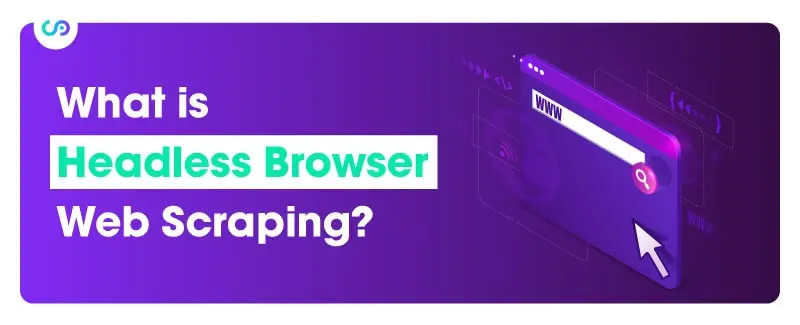
Some popular headless browser options include Puppeteer, PhantomJS, Selenium with headless mode, and Playwright. Each of these frameworks provides unique features and supports different programming languages, allowing developers to choose the one that best suits their needs.
In the next sections, we will explore the benefits of using headless browsers for web scraping and delve deeper into their functionalities to harness the full potential of web data extraction. Let’s embark on this exciting journey into the world of headless browser web scraping!
Headless Browser Scraping Techniques and Tools
When it comes to web scraping with headless browsers, developers have access to a variety of techniques and tools that simplify the scraping process and enhance their productivity. In this section, we will delve into the world of headless browser scraping techniques and explore some popular tools and libraries that facilitate this process.
One of the key techniques used in headless browser scraping is DOM manipulation. Headless browsers allow developers to navigate through the Document Object Model (DOM) of a web page, interact with elements, extract data, and perform various actions. This technique enables precise data extraction from dynamic web pages.
In terms of tools and libraries, there are several options available for developers. Puppeteer, developed by Google, is a widely used headless browser automation framework that provides a high-level API for controlling headless Chrome or Chromium browsers. It offers a range of functionalities, including page navigation, form submission, data extraction, and more.
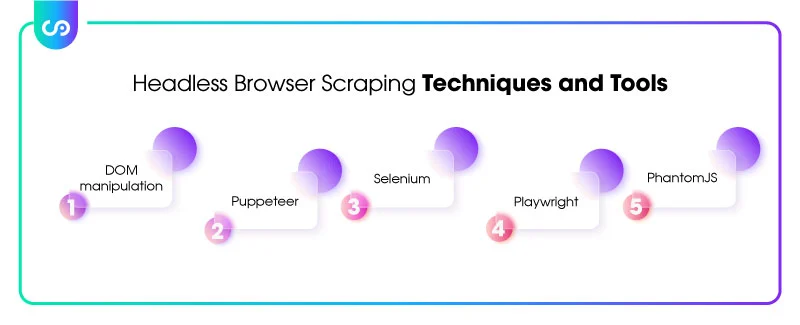
Selenium, a popular web automation framework, also supports headless mode, allowing developers to leverage its extensive capabilities for headless browser scraping. Selenium supports multiple programming languages, making it accessible to developers with different language preferences.
Other notable tools and libraries for headless browser scraping include Playwright, a cross-browser automation framework, and PhantomJS, a headless browser that provides a lightweight and efficient solution for scraping web pages.
By leveraging these techniques and tools, developers can unleash the power of headless browser scraping and extract valuable data from websites with ease. In the following sections, we will dive deeper into practical examples and use cases of headless browser scraping to demonstrate its versatility and effectiveness. Let’s embark on this exciting journey of mastering headless browser scraping techniques and tools!
Best Practices for Headless Browser Scraping
Headless browser scraping can be a powerful technique for extracting data from websites, but it requires careful planning and adherence to best practices to ensure successful and efficient scraping operations. In this section, we will explore some key best practices that will help you make the most out of your headless browser scraping endeavors.
- Emulate Human-Like Behavior: Mimicking human-like behavior is crucial to avoid detection and bypass anti-scraping mechanisms. Set realistic time intervals between requests, simulate mouse movements, and vary the order of operations to make your scraping activities appear more natural.
- Handle Dynamic Content: Many websites utilize dynamic content loaded via JavaScript. Headless browsers, equipped with JavaScript execution capabilities, allow you to interact with and extract data from such dynamic elements. Ensure that your scraping scripts handle dynamic content appropriately to retrieve the desired information.
- Implement Waiting Mechanisms: Timing is essential in headless browser scraping. Implement waiting mechanisms to ensure that the necessary elements have finished loading before interacting with or extracting data from them. This can involve waiting for specific elements to appear, waiting for page navigation to complete, or waiting for AJAX requests to finish.
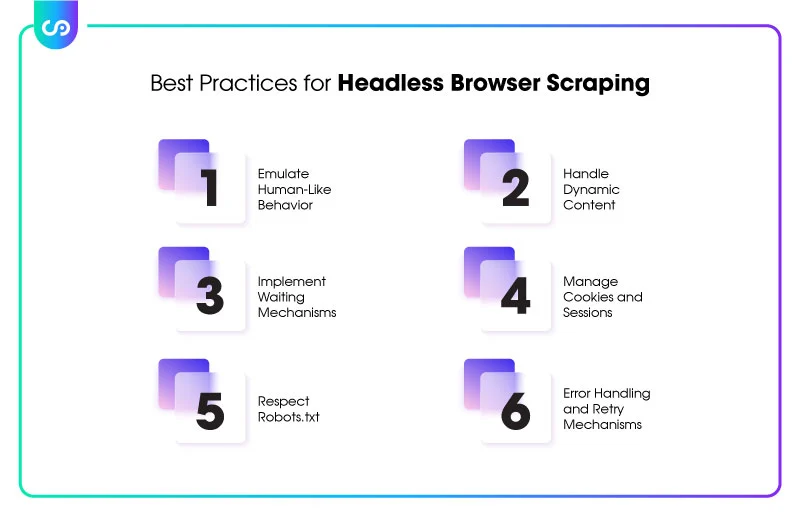
- Manage Cookies and Sessions: Some websites rely on cookies and sessions for authentication or to store user-specific data. Properly manage cookies and sessions in your scraping scripts to maintain a consistent browsing experience and avoid unnecessary disruptions.
- Respect Robots.txt: The Robots Exclusion Protocol, indicated by the robots.txt file on websites, provides instructions on which parts of a website should not be accessed by web crawlers. Respect the directives in robots.txt to ensure ethical and legal scraping practices.
- Error Handling and Retry Mechanisms: Web scraping is not always smooth sailing. Network errors, page load failures, and other unexpected issues can occur. Implement robust error handling and retry mechanisms in your scraping scripts to handle such situations gracefully and improve the overall reliability of your scraping operations.
By following these best practices, you can enhance the effectiveness and efficiency of your headless browser scraping endeavors. Remember to always be mindful of the website’s terms of service and legal restrictions, and adjust your scraping strategies accordingly. Now that you have a solid foundation of best practices, you are ready to embark on successful headless browser scraping journeys.
Examples and Use Cases of Headless Browser Scraping
Headless browser scraping offers endless possibilities for extracting data from various websites and applications. In this section, we will explore real-world examples and use cases that highlight the versatility and effectiveness of headless browser scraping techniques.
- E-commerce Data Extraction: Headless browser scraping can be utilized to extract product information, pricing details, customer reviews, and other valuable data from e-commerce websites. This data can be leveraged for competitive analysis, pricing optimization, market research, and other business intelligence purposes.
- Content Aggregation: News aggregators, content curators, and research platforms can benefit from headless browser scraping to collect articles, blog posts, and other web content from multiple sources. By automating the data extraction process, these platforms can offer comprehensive and up-to-date information to their users.
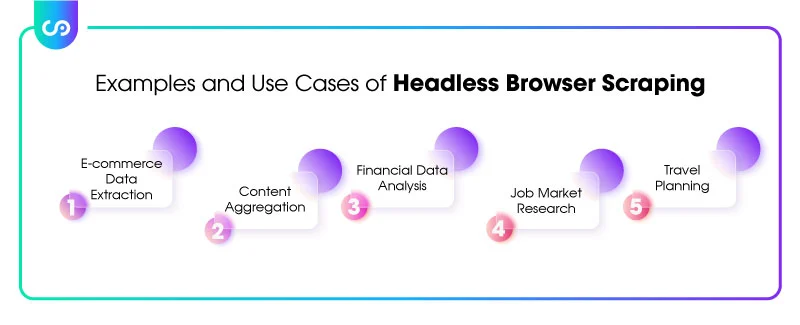
- Financial Data Analysis: Headless browser scraping can be used to gather financial data, including stock prices, market trends, and company information. This data is valuable for financial analysis, investment decision-making, and building trading algorithms.
- Job Market Research: Job portals and recruitment agencies can employ headless browser scraping to gather job postings, salary information, and skill requirements from various job websites. This data can help job seekers in their career planning and assist employers in understanding the job market trends.
- Travel Planning: Travel aggregators and vacation rental platforms can scrape data from airline websites, hotel booking sites, and travel blogs to provide users with comprehensive travel options, prices, and reviews. Headless browser scraping enables the automation of data collection, allowing users to make informed decisions based on up-to-date and accurate information.
These examples demonstrate the wide range of applications for headless browser scraping. By leveraging the power of headless browsers, businesses and individuals can automate data extraction, streamline processes, and gain valuable insights from the vast amount of information available on the web. According to Wikipedia some other use cases are:
Test automation in modern web applications (web testing)
Taking screenshots of web pages.
Running automated tests for JavaScript libraries.
Automating interaction of web pages.
Wikipedia
It is important to note that when implementing headless browser scraping, it is essential to comply with the website’s terms of service, respect their usage limits, and ensure ethical and legal scraping practices.
Conclusion
In conclusion, headless browser scraping has revolutionized the field of web scraping, enabling efficient data extraction from dynamic websites. Throughout this guide, we have explored the benefits and significance of using headless browsers for scraping purposes. Headless browser scraping offers increased flexibility, compatibility with modern web technologies, and the ability to handle complex JavaScript-rendered pages.
By utilizing headless browsers, businesses and individuals can extract valuable data for various purposes such as market research, competitive analysis, content aggregation, and more. The automation and scalability provided by headless browser scraping allow for streamlined data collection and analysis, leading to informed decision-making and improved business outcomes.
To implement headless browser scraping effectively, it is essential to follow best practices, such as handling dynamic content, managing browser instances, and respecting website policies. Regularly updating and maintaining the scraping code, monitoring website changes, and optimizing scraping techniques will ensure continued success in data extraction.
In conclusion, harnessing the power of headless browser scraping can unlock a world of possibilities in obtaining relevant and accurate data from the web. By adopting this advanced technique and adhering to ethical scraping practices, businesses can gain a competitive edge and make data-driven decisions that drive success.
FAQs
What is headless browser scraping and how does it work?
Headless browser scraping is a technique of automating website interactions and extracting data without a visible browser UI. It works by using a headless browser, which is a browser without a graphical user interface, to render and interact with web pages programmatically.
How does headless browser scraping differ from traditional scraping?
Headless browser scraping differs from traditional scraping in that it allows for the scraping of websites that heavily rely on JavaScript to render content. Traditional scraping typically involves parsing HTML directly, while headless browser scraping can execute JavaScript and handle dynamic content.
What are the advantages of using a headless browser for web scraping?
The advantages of using a headless browser for web scraping include the ability to scrape websites with dynamic content, improved compatibility with modern web technologies, and the capability to interact with web pages as a real user would. Headless browsers also provide access to a rich set of APIs and tools for scraping and automation.
Can Python be used for headless browser scraping?
Yes, Python can be used for headless browser scraping. There are several Python libraries, such as Selenium and Puppeteer, that provide bindings to popular headless browsers like Chrome and Firefox. These libraries enable developers to automate browser actions, interact with web elements, and extract data using Python code.

